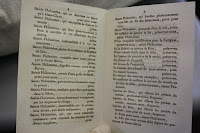I spoke about signs of provenance in one of my
previous blogs, and in particular signs that were useful to a historian or a
librarian. As I finish looking at the books in Grimes’ collection, I have
noticed how many things that people leave in their books. Whether they are
simple inscriptions or pieces of paper, these items show rare insights into the
lives of their owners. These types of finds are never guaranteed to provide
enough details to help track the ownership of the book, but sometimes you can
get lucky.
 |
| Gunpowder Voucher Lambertinis Institutionum (1750) |
One of the first items that I found was hidden in the
pages of Benedict XIV’s Institutionum Ecclesiasticarum (1750). Approximately 750 pages in, I discovered a small
piece of paper with typewritten text, handwritten text and a stamp on it. This
piece of paper was in fact a voucher for milles (1000) grams of gunpowder, issued by the Mayor’s Office in
Aix-en-Provence. The gunpowder outlined here is ‘poudre de chasse’, a French
phrase that is associated specifically with hunting. This voucher was given on
12Xbre 1850, which is short hand for 12 December. In the nineteenth century,
this would have been an important official document, and it is interesting to
find it hidden in the pages of a book about the institutions of the Church.
 |
| Inscription in He Kaine Diatheke = Novum Testamentum |
While official documents are an example of things left
behind in books, simple inscriptions can offer just as much insight. He Kaine Diatheke = Novum Testamentum (1741) is an example (a Greek and Latin title,
which in English reads ‘The New Testament = The New Testament). On the back
flyleaf of He Kaine Diatheke, a whole
page has been filled with a dedication. The author writes that he is dedicating
this booked ‘trimmed with gold’ which contains the testament and last will that
God bequeathed to ‘us wretched sinners’ which will lead his sister on the path
to eternal life. Unfortunately, the inscription is missing the end of the note,
as the page opposite it has fallen out or been removed. But it is still a
moving and thoughtful gift given to a sister, who may have been entering a new stage of her life, in marriage or travel.
 |
| Litanies for Saint Philomena |
Not all hidden surprises are handwritten or as
interesting as the previous two items discussed. One of the more common finds in
the Grimes Collection are little pamphlets for sermons or prayers. In
Chrysostom’s text Sancti Patris, Vol.
6 (1636), I found a small French prayer booklet full of litanies for Saint
Philomena. Saint Philomena is believed to be a young virgin martyr who died in
304 during the rule of Roman Emperor Diocletian. The fourteen-year-old's remains
were discovered in the catacomb of Saint Priscilla in Rome, Italy in the
nineteenth century.
I did not expect to find such treasures within the
pages of the books in Grimes’ Collection. Perhaps in my mind I expected small
blank pieces of paper as bookmarks. But it has made me consider a few
questions. Were these treasures left in their pages because Grimes did not read
these books at all and did not come across them? Or was he aware of these items
and kept them as keepsakes about his books? And are there inserts that have
been lost over the years as the Bishop came across them and decided they were
not useful to keep?
References
Farmer, David Hugh. "Philomena." The Oxford Dictionary of Saints. 5th ed. rev. ed. David Farmer. Oxford: Oxford University Press, 2011.
Institutionum Ecclesiasticarum..., 1750. University of Canterbury Rare Books Collection - 125590 - LambertinisInstitutionum - Insert
Novum Testamentum = He Kaine Diatheke, 1741. University of Canterbury Rare Books Collection - 493360 - NovumTestamentum - Provenance - EndPage
Sancti patris nostri Ioannis Chrystomi Archiepiscopi Constantinopolitan, 1636. University of Canterbury Rare Books Collection - 128906 - SanctiPatris - Vol6 - Insert2






